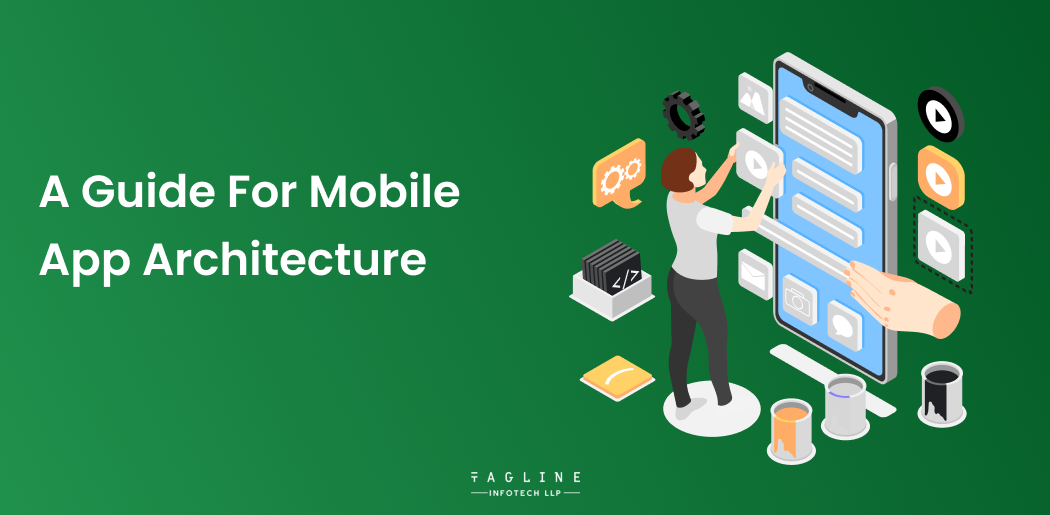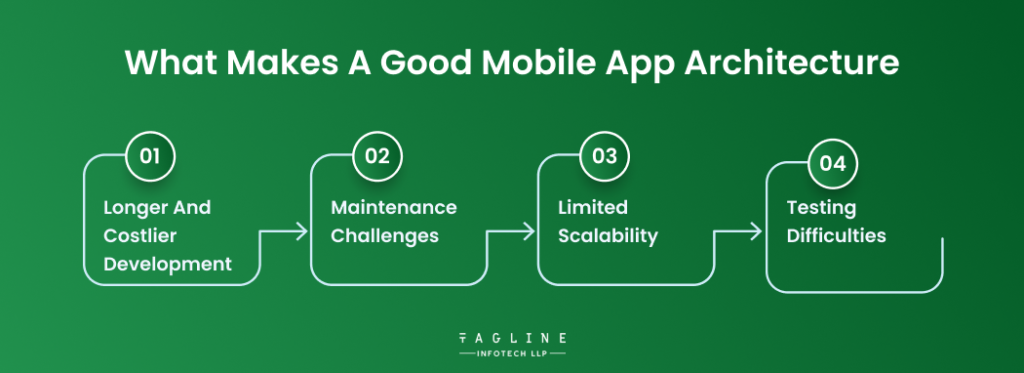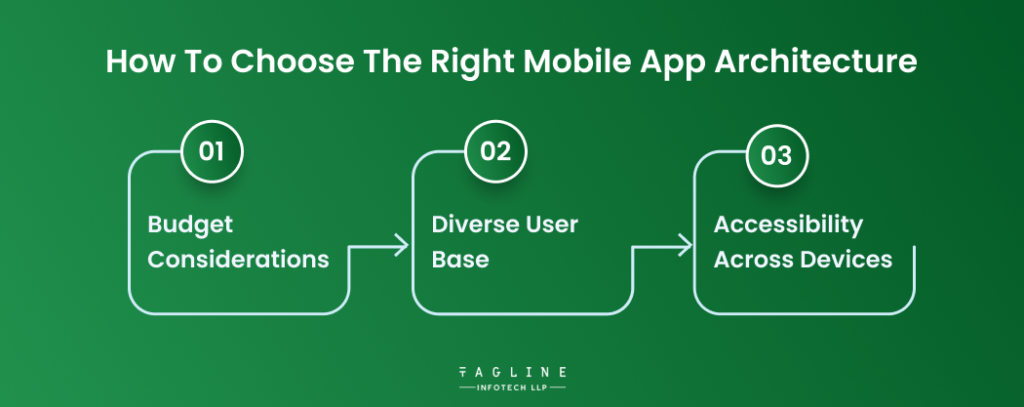What is Scalability in Cloud Computing? Types, Benefits,...
April 24, 2024
Home >> Mobile App Development >> A Guide For Mobile App Architecture

Every successful mobile application relies on a well-designed architecture that determines its structure and functionalities. In the world of mobile app development, there are various architectural patterns available to choose from.
It is crucial to carefully select the most suitable architecture for your mobile app, as it directly impacts its stability, performance, and overall quality. In this blog post, we will delve into the topic of mobile application architecture, exploring different types, discussing best practices for architecture design, and providing comprehensive insights.
Stay tuned to gain a thorough understanding of mobile app architecture and its significance in building successful applications.
The demand for mobile apps continues to skyrocket each year, with no signs of slowing down. According to Statista, the number of worldwide mobile app downloads has seen an impressive 80% increase from 2016 to 2022.
These remarkable statistics highlight the immense potential within the mobile app development industry. Businesses are increasingly investing in mobile applications to capitalize on benefits such as enhanced customer interaction, access to business services, improved customer engagement, and more.
When embarking on mobile app development, the initial crucial step involves designing the architecture of the app. Mobile application architecture serves as the foundation, much like a skeleton, upon which the app is meticulously crafted and developed.
Mobile application architecture refers to the combination of structural elements and interfaces that compose a system, as well as the behavior framework of these elements.
In simpler terms, it is a set of techniques and design principles followed to build a well-structured ecosystem for mobile apps. It can be seen as the skeleton or blueprint of an app, which influences its functionality and quality.
When we talk about mobile app architecture, we encompass everything that defines an app, such as how data flows, the user interface and experience, platform choices, and the technology stack used.
It plays a crucial role in ensuring the success of an app, especially in a competitive market where every development company strives to stand out and avoid failure.
Unfortunately, many app failures can be attributed to companies neglecting the importance of mobile application architecture diagram.
Therefore, it is essential to pay attention to the key elements and layers of a well-designed mobile app architecture. By doing so, developers can create apps that not only meet user expectations but also deliver a seamless and enjoyable experience.

There is a growing trend of developing apps without following any architecture or standards. However, this approach can lead to several drawbacks in the app development process:
Longer and Costlier Development: Without a proper architecture, the development process becomes more time-consuming and expensive.
Maintenance Challenges: In the absence of architecture, maintaining the app becomes difficult, especially when there are staff changes.
Limited Scalability: Apps without architecture are harder to build upon and scale, limiting their potential for future expansion.
Testing Difficulties: Lack of architecture makes testing more challenging, increasing the chances of errors and bugs.
To avoid these problems, it is essential to establish a well-defined mobile app architecture.
By incorporating good software development principles like KISS, DRY, and SOLID, this architecture can streamline the development process, facilitate data flow, and provide a clear roadmap for future app expansion.
A solid mobile app architecture promotes flexibility, supports Agile development methods, improves testing efficiency, and simplifies maintenance, ultimately saving both time and money.
It’s important to note that a good architecture should not be limited to a specific platform but should apply to both native and cross-platform choices, ensuring a unified approach to development.
If we envision mobile app architecture as a skeleton, we can then create layers (or bones) to construct the crucial components of the app.
When determining the mobile application architecture, it is crucial to consider the device type. This entails studying the screen size, resolution, CPU characteristics, memory, storage space, and the availability of the development tool environment.
The app features depend on the software or hardware, making it essential to have details about the devices the app will run on.Throughout the app’s lifecycle, there will be instances of limited or no internet connectivity.
It is important to construct the mobile application architecture diagram while considering the worst network conditions.
Designing the data access mechanism, caching, and state management accordingly is necessary for these scenarios.
The user interface (UI) and user experience (UX) of an application play a vital role. It is crucial to ensure that the UI is designed to engage users and provide them with a streamlined experience.
This aspect greatly influences the overall design of the mobile application infrastructure.
The navigation approach is an important consideration in app architecture design. It requires expertise in both backend and frontend development.
Understanding the target audience and their app requirements is key to analyzing which navigation approach will work best for the app, such as stacked navigation bar, single view, scroll views, tab controller, search-based, model controller, or gesture-driven.
When designing the mobile application architecture diagram, it is important to decide whether users require real-time updates or push notifications.
Real-time updates can be compelling but may come with a higher cost and potential battery and data drain.
Mobile app architectures are typically divided into layers. Understanding these layers helps mobile app development companies comprehend the composition of different architectures.
Now, let’s delve into the components of mobile application architecture.
Are you looking a developer to create your own mobile app?
Connect with our team to craft apps that fits your unique needs, enhance productivity, and drive profitability!
Presentation Layer
The aim of this layer is to look into how to present the application to end users. When designing this layer, the mobile app developers must identify the correct client type for intended infrastructure. Additionally, the client’s deployment restrictions must also be kept in mind.
Another necessity is selecting the correct data format and using robust data validation mechanisms for protecting the apps from invalid entry.
Business Layer
In mobile application architecture, each layer serves a crucial purpose in delivering a seamless user experience.
The Presentation Layer focuses on how the application interfaces with end users. Mobile app developers must carefully consider the client type and deployment restrictions, while also implementing robust data validation mechanisms to safeguard against invalid inputs.
Moving on to the Business Layer, this is where the focus shifts to the business aspects presented to users. It encompasses business components, workflows, and entities within the Domain model and Service sub-layers.
The Service layer defines the core application functions available to users, while the Domain model layer delves into specialized knowledge related to specific problem domains.
Data Layer
plays a vital role in meeting application requirements for efficient and secure data transactions. Developers must also account for data maintenance and ensure adaptability to evolving business needs.
Within this layer, we find components like access components, utilities, helpers, and service agents, all dedicated to managing data effectively.
Mobile architecture patterns consist of two key subheads: Persistence Layer and Network Layer.
The former simplifies data access stored in the mobile app backend architecture, while the latter is essential for executing networking calls.
Understanding what constitutes a good mobile app architecture hinges on the principles it is built upon. This foundation sets the standard for a robust and effective architectural framework, ensuring a seamless user experience and future adaptability.
When discussing the mobile application architecture, Android apps have their own specific development with languages like Kotlin and Java, built for a range of devices from Google, Samsung, Sony, and Nokia.
The most widely accepted architecture for mobile apps is Clean Architecture, which is based on layers and the inversion of control.
It follows a three-layer structure, with the business layer referred to as the domain layer. Clean Architecture ensures that the domain/business layer does not depend on the other layers, but instead makes use of interfaces.
This mobile app architecture diagram makes it easy to scale and add to apps.
Mobile application architecture has been established by Apple with the MVC Model (Model-View-Controller).
This model is comprised of three components: the Model, which deals with data such as persistence and networking code, the View which is the representation of the app to the user, and the Controller, which is a mediator layer that communicates with an abstraction.
With this architecture, mobile app development is accelerated and can support multiple views – a great option for mobile development. Objective-C and Swift are the two languages used to develop native iOS apps.
Mobile application architecture is a combination of native and web solutions. Hybrid apps use native applications as the outer layer, while the inner layer is powered by platform-independent JavaScript, HTML, and CSS.
Through plugins such as Apache Cordova or Ionic Capacitor, hybrid apps are able to access the device’s underlying native features.
This type of mobile app architecture is the fastest way to create an app for a variety of platforms while also ensuring easy updates, however, it may not be suitable for complex, interactive, or feature-rich applications.
“How to patent a mobile app idea? “
– Also Read Article
Mobile application architecture, like hybrid architecture, utilizes a single codebase with platform-specific capacities in each native environment.
Instead of web language, cross-platform apps depend on frameworks like React Native and Xamarin.
This approach provides a user experience that is more similar to native, making it a preferred choice for many.

Understanding the significance of mobile application architecture is pivotal in making informed decisions for your app’s development. When it comes to choosing the right architecture design, consider the following advice:
Budget Considerations: If budget isn’t a constraint, developing native applications can offer a range of advantages, including seamless functionality and optimal performance.
Diverse User Base: If your target audience spans both Android and iOS users, it’s wise to opt for either cross-platform apps or create native versions for each platform to cater to a wider user base.
Accessibility Across Devices: Opting for a hybrid solution can be a strategic move, enabling access to your brand from a diverse range of devices.
It’s crucial to recognize that there exist various principles and architectural patterns in mobile app development, each with its own set of strengths and limitations. The architecture you choose forms the bedrock of your app, directly influencing its performance and stability.
When making the decision regarding your mobile app’s architecture, take into account several influencing factors such as business requirements, application type, desired functionality, chosen tech stack, required flexibility, and development timeline.
Ultimately, it’s imperative to carefully evaluate different app architectures in light of your specific needs and constraints, ensuring that you select the architecture that aligns best with your mobile app’s objectives and long-term success.
This thoughtful approach to mobile app architecture sets the stage for a robust and effective application.
Creating the right architecture for your mobile application is a key factor in deciding whether or not the app will be successful. Your business needs and user stories can help you decide which features to add and what type of structure you should use.
All aspects, including security, scalability, and performance, must be taken into account. If you need help with this process, you can look for a tech partner to assist you.
Tagline Infotech is a reliable software development partner that can help you create innovative mobile apps with the latest features.
It is necessary to have the best mobile app architecture for your business because it saves a lot of time to build a mobile app. Mobile app architecture also eases the process of app testing and maintenance.
Hybrid mobile application architecture is used to create different types of hybrid mobile applications that can easily run on platforms like Android, iOS, and many more.

Digital Valley, 423, Apple Square, beside Lajamni Chowk, Mota Varachha, Surat, Gujarat 394101
+91 9913 808 2851133 Sampley Ln Leander, Texas, 78641
52 Godalming Avenue, wallington, London - SM6 8NW